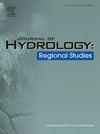Evaluating combinations of rainfall datasets and optimization techniques for improved hydrological predictions using the SWAT+ model
IF 4.7
2区 地球科学
Q1 WATER RESOURCES
引用次数: 0
Abstract
Study Region
This study focuses on the Cape Fear and Tar-Pamlico watersheds in North Carolina, which are characterized by diverse hydrological conditions, varied land use, soil types, and hydrological characteristics.
Study Focus
The primary goal of this study is to examine the combined effects of three satellite precipitation products (SPPs) — ERA-5, gridMET, and GPM IMERG — along with three autocalibration techniques — DDS, GLUE, and LHS — on SWAT+ river flow predictions. Flow accuracy was assessed using three evaluation metrics: NSE, KGE, and R².
New Hydrological Insights for the Region
Key findings revealed that five SWAT+ parameters (cn2, revap_co, flo_min, revap_min, and awc) were consistently sensitive across all SPPs and watersheds, with rainfall products exerting a greater influence on simulated river flow than optimization techniques. Among the SPPs, GPM IMERG performed the best, followed by ERA-5 and gridMET, while NSE was more responsive to changes in SPPs and calibration methods than KGE and R². For the Cape Fear and Tar-Pamlico watersheds, the study highlighted SWAT+ 's challenges in predicting base flow for groundwater-driven systems and demonstrated the potential of optimization techniques to improve flow simulations despite poor satellite-gauge rainfall correlation. The combination of the GPM IMERG dataset and the GLUE method proved most effective, offering valuable guidance for selecting optimal datasets and methods to enhance prediction accuracy in complex watersheds.
求助全文
约1分钟内获得全文
求助全文
来源期刊

Journal of Hydrology-Regional Studies
Earth and Planetary Sciences-Earth and Planetary Sciences (miscellaneous)
CiteScore
6.70
自引率
8.50%
发文量
284
审稿时长
60 days
期刊介绍:
Journal of Hydrology: Regional Studies publishes original research papers enhancing the science of hydrology and aiming at region-specific problems, past and future conditions, analysis, review and solutions. The journal particularly welcomes research papers that deliver new insights into region-specific hydrological processes and responses to changing conditions, as well as contributions that incorporate interdisciplinarity and translational science.
 求助内容:
求助内容: 应助结果提醒方式:
应助结果提醒方式:


